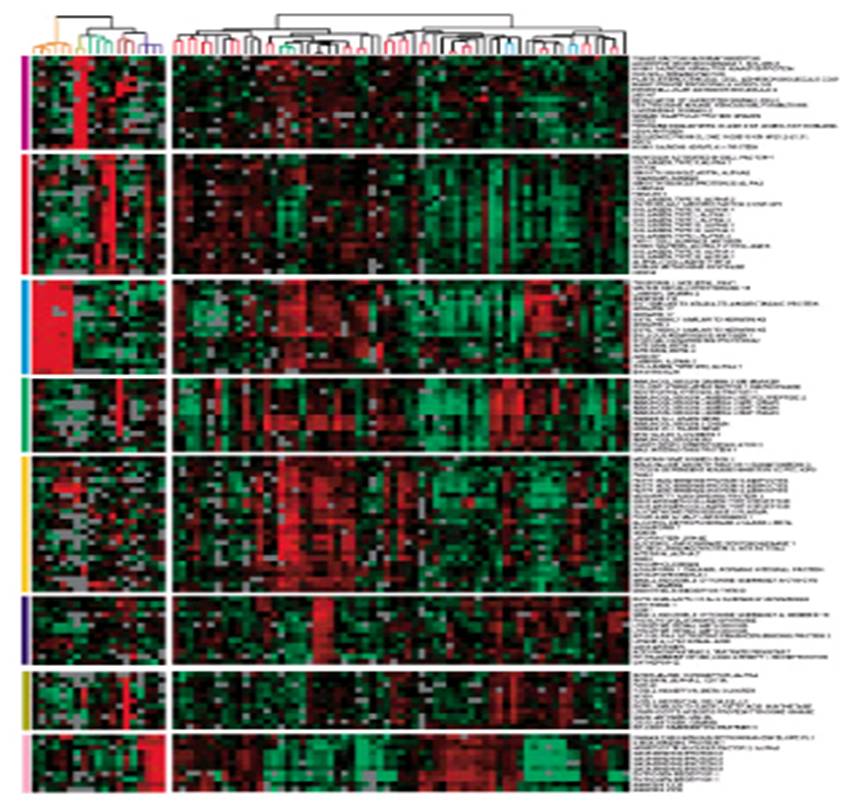Personalized Medicine-Guided Therapy for Breast Cancer

Finding patterns of gene expression in patients with cancer is difficult, owing to the large amount of data generated from microarrays. The above image testifies to this complexity, and represents the gene expression levels of many different genes (rows of the array) in each of 84 individuals (columns of the array). Green represents a gene expression level that is below the mean for the data set, black squares represent expression levels equal to the mean, and red represents a gene expression level higher than the mean. Gray boxes correspond to missing data. Taken from Perou et al. Nature 406, 747-752 (2000).
Prediagnostic Screening
Individuals with a family history of breast cancer are often screened early in life for the presence of the BRCA1 and BRCA2 genes, which genetically predispose the individual to developing early-onset breast cancer. While the presence of the gene does not neccessarily mean that the individual will develop breast cancer, the individual is at greater risk. Knowing this information, the patient can take steps to reduce the risk of developing the disease. This can include lifestyle changes, such as exercising and losing weight or quitting smoking, and prophylactic surgeries such as mastectomy or oophorectomy. Once breast cancer is diagnosed, the presence or absence of these genes in the patient will help the physician select a more effective drug for the patient.
[back to top]
HER-2 inhibitors
Researchers have discovered that 20-25% of women afflicted with breast cancer show amplification of the HER-2 (Human Epidermal growth factor Receptor) gene. Overexpression of this gene leads to an abundance of the protein on the surface of cells. To determine the abundance of the protein on a cell's surface, a section of tissue is biopsied, fixed on a slide and stained with antibodies to this receptor. These results in a very specific stain that shows clearly the presence and abundance of this receptor. This process is known as immunohistochemistry. Another method is to detect the presence of the genetic sequence on the chromosomes using fluorescent probes, in a technique known as Fluorescence In-Situ Hybridization (FISH). For patients who show an abundance of the cell surface protein HER-2, the monoclonal antibody therapeutic agent known as trastuzumab (Herceptin) is used. In some patients who do not respond to this drug, a small molecule tryosine kinase inhibitor, lapatinib, is used and in some cases is more effective. In order to avoid the administration of more traditional chemotherapeutic compounds which have serious side effects, genetic testing is helpful to determine if one of the two drugs mentioned above would provide more benefit to the patient without these traditional drugs. However, recent research has underscored the need for genetic testing of the expression of multiple genes. In recent studies, when both HER-2 and MYC (a gene coding for a transcription factor) are overexpressed, a combination of the drug trastuzumab and traditional chemotherapy has provided the best therapeutic outcome for patients.
back to topTopoisomerase inhibitors
Many traditional drugs used for breast cancer treatment belong to a class of compounds known as anthracyclines, which inhibit topoisomerase IIalpha. However, despite their popularity for therapy, not all patients will benefit from their administration. Studies have shown that patients that benefit the most from anthracycline therapy overexpress the TOP2A gene, or have a portion of this gene deleted. This gene codes for the topoisomerase, and is detected using immunohistochemistry or FISH (explained above). Thus, genetic tests guide breast cancer therapy by testing for the expression levels of both HER-2 and TOP2A. When overexpression of both genes exists, anthracyclines are given in conjunction with trastuzumab for the most beneficial therapy. However, when only HER-2 is overexpressed and TOP2A is not, anthracyclines do not provide as much therapeutic benefit as trastuzumab alone. Due to the harmful side effects frequently caused by anthracyclines (including cardiomyopathy in some cases), it is beneficial for patients to restrict their administration if it is not neccessary. In this way, genetic testing has enabled more effective treatment of some types of breast cancer, while minimizing the side effects from unneccessary or ineffective treatment options.
back to top